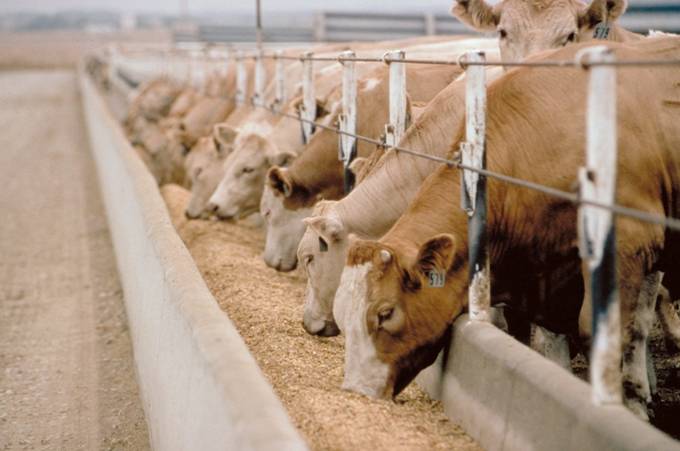
Agricultural News
Variety of options available to producers needing to dispose of livestock carcasses after recent storms
Thu, 26 May 2011 14:00:46 CDT
 Oklahoma's recent tornado outbreak has left some agricultural producers facing the need to dispose of animal carcasses.
Oklahoma's recent tornado outbreak has left some agricultural producers facing the need to dispose of animal carcasses.
State criminal statutes require the following:
- It shall be unlawful to bury any carcass in any land along any stream or ravine, where it is liable to become exposed through erosion of the soil or where land is subject to overflow at any time;
- It shall be unlawful for any person to leave or deposit the carcass of any animal, chicken or other fowl, whether it shall have died from disease or otherwise, in any well, spring, pond or stream of water; or leave or deposit the same within a quarter mile of any occupied dwelling or any public highway without burying; and
- Every person who violates the two preceding sections shall be guilty of a misdemeanor.
According to state guidelines, producers have five options: rendering, placing the animal in landfills, burial, incineration and composting.
"Rendering has long been one of the best choices and provides benefits to the environment, public health and animal health; unfortunately, it is becoming increasingly expensive," said Ron Kensinger, head of the Oklahoma State University Department of Animal Science.
Cattle carcasses in particular are becoming more difficult and expensive to send to rendering because of federal regulations. The Food and Drug Administration prohibits using parts of cattle 30 months or older to produce any food for dogs, cats and other animals unless the spinal cord and brain are first removed.
Likewise, placing the animal in a landfill may require notification before delivery and possibly documentation from a licensed veterinarian stating the cause of death.
"Landfill tipping fees should be assessed and may range from $20 to $30 per ton," said Josh Payne, OSU Cooperative Extension area animal waste management specialist. "Other considerations are transportation costs and breeches of biosecurity by moving carcasses off-farm."
For a list of Oklahoma landfills that accept dead animals, click here.
"Burial is a viable option for many producers, as long as they make sure to follow state guidelines," said Nathan Anderson, Payne County Extension director and agricultural educator for OSU's Division of Agricultural Sciences and Natural Resources.
Oklahoma's general carcass burial disposal guidelines are:
- Burial of dead livestock requires the construction of a pit;
- Do not locate the burial pit closer than one foot vertically above the flood plain or within two feet of the water table or bedrock;
- Do not locate the burial pit within 300 feet of wells, waters of the state, neighboring residences, public areas or property lines; and
- After placing the carcasses in the pit, bury the dead animals with a minimum of two-and-a-half feet of topsoil, making sure to inspect the site routinely to ensure that wild animals are not digging and dragging a carcass away.
Be aware that open-air incineration of carcasses is not allowed unless the animal died of a contagious or infectious disease. Self-contained, closed incinerators and air-curtain incinerators are allowed for animals that perished as a result of the recent storms.
"Composting also is a viable option for many producers," Anderson said. "However, dumping a carcass in the woods or on some back pasture to rot or be eaten by scavengers is not composting, plus it is illegal."
Anderson said there are a number of good reasons why dumping a carcass and leaving it to rot is against the law:
- It risks disease transmission to other livestock, the producer's own and those owned by neighboring farm and ranch operations;
- It risks disease transmission to wildlife;
- It may contaminate water sources, including the producer's own well and those of neighboring farm and ranch operations or residences; and
- It may attract vermin and pests, including coyotes, that may transmit disease and prey on livestock.
"Just dumping a carcass and leaving it to rot generally will alienate neighbors and tends to cast the entire animal agriculture industry in a bad light," Anderson said. "Be responsible to yourself, your family, your neighbors, the industry and the environment."
Detailed information on removal of carcasses through the use of composting is available by reading OSU Extension Fact Sheet BAE-1749, "On-Farm Mortality Composting of Livestock Carcasses."
"Be aware that licensed Concentrated Animal Feeding Operations and Registered Poultry Feeding Operations must receive permission from the Oklahoma Department of Agriculture, Food and Forestry's Agricultural Environmental Management Services (AEMS) Division prior to composting or burial, unless an operation's approved animal waste management plan allows for composting," Payne said.
AEMS can be contacted by phone at 405-522-4659.
Additional information about options producers can use to dispose of carcasses is available by reading OSU Extension Fact Sheet BAE-1748, "Proper Disposal of Routine and Catastrophic Livestock and Poultry Mortality."
To read more about these carcass disposal options on the OSU Extension Fact Sheets, click here.
WebReadyTM Powered by WireReady® NSI
Top Agricultural News
More Headlines...



















